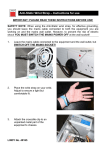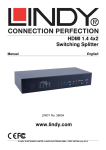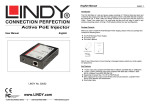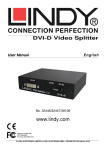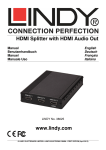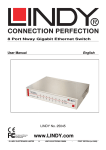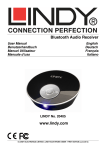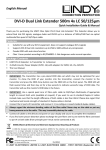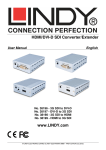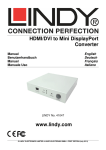Download Lindy 20519
Transcript
Wireless Audio Extender User Guide English No. 20519 www.lindy.com © LINDY ELECTRONICS LIMITED & LINDY-ELEKTRONIK GMBH - FIRST EDITION (July 2011) Wireless Audio Extender User Guide Introduction Thank you for purchasing the LINDY Wireless Audio Extender. This Wireless Audio Extender enables you to wirelessly transmit music from m your PC or Notebook to speakers located in another room or to headphones as you move around. Features • • • • • Proprietary 2.4GHz Wireless solution Easy system expansion with th stereo sound support Plug and play, quick and convenient use, no driver / software installation Low power consumption / Low audio noise Volume controlled through your computer or manually on the adapter Package Contents • • • • • • Wireless Audio Extender Receiver Wireless Audio Extender Transmitter Dongle Neckband Printed LINDY manual, English Battery, Type AAA Multi Country Switching PSU, 5V DC, 1A, positive polarity Installation Caution: Do not connect the external power adaptor when a battery is inserted in the Receiver. 1. Insert the Transmitter Dongle into an available USB port on your computer, the Power / Association LED will begin to blink. 2. Connect headphones or speakers to the Audio Output port of the Receiver. 3. Insert a battery or connect the power adapter to the Receiver and power it on by pressing the PWR Button for 3 seconds,, the Power / Association LED will begin to blink. 4. To associate the transmitter and receiver units press the Pairing button utton on the Transmitter for 3 seconds,, then press the Volume Control button on the Receiver until you hear a repeated beep from the headphones or speakers you have connected. 5. The pairing process is now complete and you can start to use the Wireless Audio Extender Extender. Wireless Audio Extender User Guide Specification Item Description Tx USB RF Dongle USB Type A Male Rx Audio Output 3.5mm Stereo Audio Jack Female Rx Power DC Power Jack Interface RF Band 2.4 GHz RF data rate Up to 2 Mbps , GFSK modulation Audio Output 2 channel Audio Out Sample rate 48KHz with 16-bit downstream USB 1.1 full speed specification at transfer rate to 1.5 / 12 Mbps Audio Compliance Supports LPCM and Compressed format 16-bit 2-channels Tx Power Mode Bus-powered Input Rx Power Supply :AC 100-240V ; Output : DC 5V /1A AAA 1.5V battery x 1 Power consumption LED Operational Range Rx less than 50mA @ 2.5V Blinking when powered on , lights up when data transfer between Tx and Rx Up to 45 metres Windows 2000, XP , Vista and Windows 7, Operating System Support Mac OS X v10.x or higher Working Environment Operating Temperature 10~40 degrees (Celsius) Storage Temperature 0~70 degrees (Celsius) Humidity 0 ~ 80% Wireless Audio Dongle 52 (L) x 19 (W) x 10 (H) (mm) Wireless Audio Box 58 (L)x 55 (W) x14 (H) (mm) Dimensions Certification CE Certification This equipment complies with the requirements relating to Electromagnetic Compatibility Standards EN55022/EN55024 and the further Standards cited therein. FCC Certification This equipment has been tested and found to comply with the limits for a Class B digital device, pursuant to part 15 of the FCC F Rules. These limits are designed to provide reasonable protection against harmful interference in a residential installation. You ou are cautioned that changes or modification not expressly approved by the party responsible for compliance could void your authority to operate the equipment. This device complies with part 15 of the FCC Rules. Operation is subject to the following two conditions: onditions: 1. This device may not cause harmful interference, and 2. This device must accept any interference received, including interference that may cause undesired operation. WEEE (Waste of Electrical and Electronic Equipment), Recycling of Electronic ic Products United Kingdom In 2006 the European Union introduced regulations (WEEE) for the collection and recycling of all waste electrical and electro electronic equipment. It is no longer permitted to simply throw away electrical and electronic equipment. Instead, Instead, these products must enter the recycling process. Each individual EU member state has implemented the WEEE regulations into national law in slightly different ways. Please follow your national law when you want to dispose of any electrical or electr electronic onic products. More details can be obtained from your national WEEE recycling agency. Germany Die Europäische Union hat mit der WEEE Direktive umfassende Regelungen für die Verschrottung und das Recycling von Elektro- und Elektronikprodukten geschaffen. Diese wurden von der Bundesregierung im ElektroElektro und Elektronikgerätegesetz – ElektroG in deutsches Recht umgesetzt. Dieses Gesetz verbietet vom 24.März 2006 an das Entsorgen von entsprechenden, auch alten, Elektro- und Elektronikgeräten über die Hausmülltonne! Hausmülltonne! Diese Geräte müssen den lokalen Sammelsystemen bzw. örtlichen Sammelstellen zugeführt werden! Dort werden sie kostenlos entgegen genommen. Die Kosten für den weiteren Recyclingprozess übernimmt die Gesamtheit der Gerätehersteller. France En 2006, l'union Européenne a introduit la nouvelle réglementation (DEEE) pour le recyclage de tout équipement électrique et électronique. Chaque Etat membre de l’ Union Européenne a mis en application la nouvelle réglementation DEEE de manières légèrement différentes. érentes. Veuillez suivre le décret d’application correspondant à l’élimination des déchets électriques ou électroniques de votre pays. Italy Nel 2006 l’unione europea ha introdotto regolamentazioni (WEEE) per la raccolta e il riciclo di apparecchi elettr elettrici ed elettronici. Non è più consentito semplicemente gettare queste apparecchiature, devono essere riciclate. Ogni stato membro dell’ EU ha tramutato le direttive WEEE in leggi statali in varie misure. Fare riferimento alle leggi del proprio Stato quando si dispone di un apparecchio elettrico o elettronico. Per ulteriori dettagli fare riferimento alla direttiva WEEE sul riciclaggio del proprio Stato. LINDY No. 20519 1st Edition July 2011 www.lindy.com




